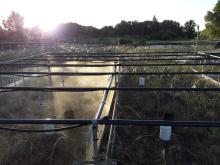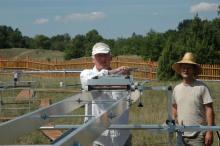This study is aimed at understanding how future extreme droughts and chronic changes in precipitation will alter the structure and function of open sand grasslands. This grassland ecosystem provides habitat for many endemic and protected species and is sensitive to changes in precipitation. The research site is a highly equipped climate change experiment for studying the separate and interactive effects of a single extreme drought (2014) and chronic (multi-year) manipulation of precipitation (drought and water addition in summer since 2015). Scientific focus: We study (a) plant diversity, (b) net primary productivity, (c) fine-scale plant species assembly, (d) litter decomposition, (e) soil arthropod diversity, (f) nematode diversity, (g) fungal diversity, (h) plant root biomass and activity, (i) organic carbon storage, and soil respiration.
Climate, soil, and vegetation characteristics
- temperate continental climate with sub-Mediterranean influences
- mean annual temperature is 11.8 °C, and mean annual precipitation is 601.2 mm (2013-2023)
- peak precipitation usually occurs in June (about 70 mm), often followed by a midsummer drought.
- the soil of the study area is nutrient-poor, coarse-textured sand soil with low organic matter content (calcaric arenosol)
- the unique flora of the open sand grasslands is adapted to edaphic conditions (water limitation), it is sensitive to changes in precipitation, perennial grassland are dominated by Festuca vaginata or Stipa borysthenica, annuals are abundant in disturbed plots (Secale sylvestre, Bromus spp.)
Experimental tools
- a fenced area, about 1 ha (46°52’N, 19°25’E; 108 m a.s.l.)
- iron frames around the study plots
- wooden footpaths to minimise the trampling effect
- automated meteorological sensors
- a central building for data loggers, alarm systems, online camera
- electricity is provided by earth cables starting from the farm-house
- transparent polyethylene roofs to exclude precipitation, pipes to channel the excluded water
- rainwater collection and storage system, irrigation system in the plots
Experimental design, treatments applied
- extreme drought treatment with two levels: extreme drought (X) and control (C)
- chronic precipitation treatment with four levels. severe drought (S), moderate drought (M), control (C), and water addition (W)
- eight combinations of treatments arranged in a full factorial design
- six replicates: blocks, two 6 by 6 meters parcels, 8 plots per block, a total of 48 study plots
- 3 by 3-meter plots, 2 by 2 meters sampling quadrats, and a half-meter wide buffer zone, all treatments were applied to the whole area of the plots.
- 2013 pre-treatment year, construction and sampling
- started in 2014, extreme drought was applied from mid-April till mid-September, we permanently covered plots (X) with transparent polyethylene roofs. During this period, we excluded all precipitation events (523.5 mm), which was a considerable part of that year's total amount (817.3 mm).
- since 2015, chronic precipitation treatments have been applied. In the case of severe drought, we cover plots (CS and XS) for two months from late June till late August. In the case of recurrent moderate drought, we cover the plots (CM, XM) for about one month from late July to late August. Water addition is carried out four times yearly in CW and XW plots in May, June, July and August. We add 100 mm of water, 25 mm per month, simulating the properties of incoming precipitation during a typical thunderstorm. We use collected rainwater sprayed from about 70 cm height by 14 sprinklers in each 3 x 3 m plot.
Meteorological data
- meteorological data of a nearby (within 100 m) standard weather station of the Hungarian Meteorological Service
- micrometeorology:
- air temperature and air humidity are measured 20 cm above the surface
- precipitation
- soil temperature at 20 cm depth
- soil moisture at two different depths (0-30 cm and 70-100 cm)

